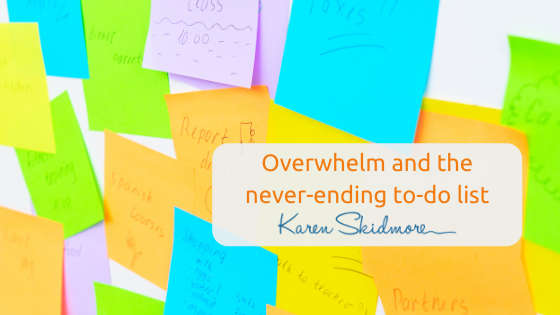I get it. There are times that you find yourself in the trenches of to-dos. No matter what’s gone on before and how well prepared and organised you may have felt last month, stuff can easily pile up and get on top of you.
Sometimes it shows up as piles of post-it notes and scraps of paper, but in most cases, it’s a mental overload. You’ve got too much thinking going on and your brain can’t keep up with the number of tabs you’ve got open; you need to close down your mental browser.
Multi-tasking is a productivity myth and the word ‘priorities’ is a modern-day oxymoron.
You can NOT have more than one priority at one time.
But we are speeding up and trying to get more stuff done more than ever, so it’s no surprise that the feeling of overwhelm and the never-ending to-do list are common problems amongst entrepreneurs and mico-business owners like you.
I’ve been triggered to write this article this week because the conversation of how to deal with too much to do has come up in several client sessions these past few weeks. It’s Week 5 of my Momentum members’ 90 Day Plans and, at this time, I ask them to complete the 4 Week Review & Re-Do process.
Making time to review your progress every 3 or 4 weeks and map out the detail of the tasks for the next few weeks is critical to avoid overwhelm. I know this may feel counter-intuitive to stop and take time out but if you don’t, you run the risk of getting stuck in the trenches.
This is why I wanted to share this with you today because I know how easy it is to find yourself in overwhelm.
1) Dump it
The first step to take is to get everything out of your head on to paper. Having things swirling around your head is exhausting and your brain simply can’t cope. Don’t try to organise your thoughts at this stage; simply dump what’s in your head onto a piece of paper.
This isn’t a brainstorming session; you probably DON’T need new ideas right at this moment in time, yes? You are simply getting everything out of your head so you can then organise them and see when and where you get them done.
2) Chunk it
There’s every chance your to-dos are covering a multitude of projects; from updating your website to preparing for a new product launch to planning out your content for the next few months. So rather than just write a big long list, get a piece of paper for each project and chunk out your tasks in relation to the project.
Mind mapping can be a useful tool for this as this allows you to spider out your thoughts and get the detail out. The more ‘little things’ that can get out on to paper, the less of these ‘little things’ are going to take valuable space in your head.
If you manage a home as well as a business, I would also recommend you have a separate piece of paper for Family Inc stuff, too. You’re making it even harder for yourself by constantly switching your thinking from one to the other. So separate them out and don’t try to mix Family Inc stuff with business stuff.
3) Diarise It
This is the ‘magic’ step that most people don’t do and will make a HUGE difference to you getting the ‘right’ stuff done.
You have to stop using linear to-do lists and start to put your tasks into your diary. If you don’t decide when and where you are going to take action on what needs doing, you will find you will never get to the bottom of your list because you will simply keep adding more stuff. It’s a game you are never going to win.
Stephen Covey’s quadrant is a simple decision making task tool that I’ve used for a long time. When you ask yourself how urgent and important each item on your paper is to you right now, you will discover that very little on these lists you’ve written out will need doing RIGHT NOW.

80% or more will fit into either the DIARISE IT box or the DELEGATE IT box.
You may even find that 10% or more fits very nicely into your DUMP IT box as you realise that task you’ve written down is simply a busy-thing. If it’s not urgent or important, then cross it out.
By thinking about when and where each thing on your list needs doing, start to work out which order they need to do in. Sometimes it’s helpful to write out each task on to a post-it note and move them around until you feel you’ve got them in a reasonable step-by-step order.
For example, if you are dealing with a website update project, it maybe you have to finish writing two pages of content before your website designer can move ahead with giving you the next design draft to look at. Get clear on what deadlines you are working towards (quick check: do your deadlines need to be pushed back?) and then see what needs to happen first before the next thing and this way you can stop your mind seeing everything as important.
Once you’ve got your tasks in order, decide how long each task is going to take you (always over-estimate … never kid yourself that something will take ‘just 5 minutes’!) and then get your calendar open and decide when you are able to get these done.
If you really can’t see how you are going to get everything done in the time that you’ve got available, then re-check your tasks against the DELEGATE IT option on your Covey Quadrant. Are you trying to do too much yourself?
4) Psychology before technology
Grace Marshall from Productivity Ninja introduced me to this phrase recently. I love it because this simple phrase articulates perfectly what I’ve been advocating over the past 10+ years whenever someone asks me which productivity tool I’d recommend.
There are hundreds of really great productivity apps and dashboards on the market, however, a productivity tool will NOT help you get stuff done. They will only give you a place to organise your thoughts so you have to work out how you work first.
I know I am not the only one who has spent hours setting up a new productivity dashboard, set the colours and added my to-do list, to then never use the bloody thing. We think a tool that is designed to make us productive will make us productive. But that is simply not the case. It is just a tool to support us in the way that we work.
So work out the way you like to work first and, in my experience, analogue pen and paper systems are often the simplest and most efficient ways of keeping focused week by week. Yes, if you have a team working on different parts of a big project, an online project management system can be critical to keeping everyone aligned and ensure the deadlines are met. But my advice to you is to try a simple analogue system first; flip charts, whiteboards and an online diary are the three productivity tools that have worked best for me over the past 15+ years.
If you want to learn more about productivity tips and tricks, then I can highly recommend spending some time over at Grace’s blog https://grace-marshall.com/category/tips-tools-tricks/
It will be time well spent … especially if you then spend the time to implement her insightful and practical advice.
That’s all from me today. I’d love to you know how this has helped your thinking around getting stuff done so leave a comment below.








